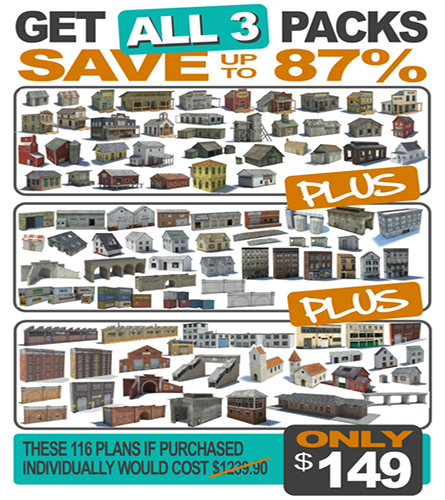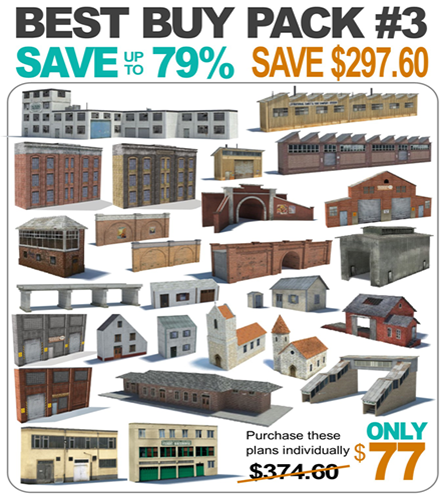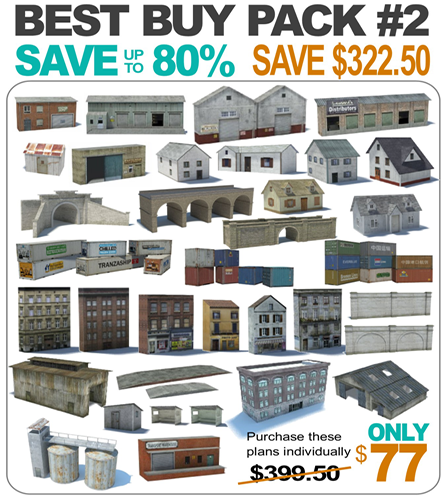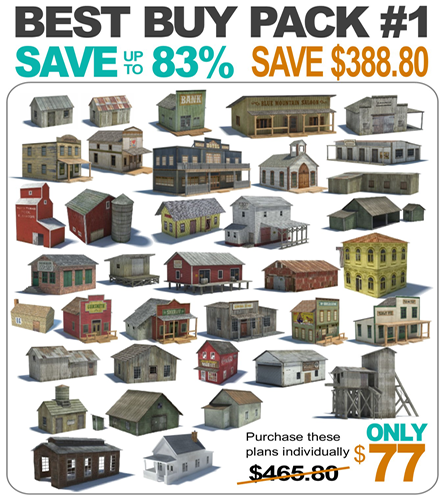Monster Pack Deals
-
Get All 3 Monster Packs
bundle productsRated 0 out of 5$1,239.90Original price was: $1,239.90.$149.00Current price is: $149.00. -
Monster Pack Deal 3
bundle productsRated 0 out of 5$374.60Original price was: $374.60.$77.00Current price is: $77.00. -
Monster Pack Deal 2
bundle productsRated 0 out of 5$399.50Original price was: $399.50.$77.00Current price is: $77.00. -
Monster Pack Deal 1
bundle productsRated 0 out of 5$465.80Original price was: $465.80.$77.00Current price is: $77.00.
These packs are the best buys in HIGH QUALITY downloadable scale model railroad buildings you’ll find anywhere. Each scale model printable paper building is carefully detailed to a photo-realistic quality complete with intricate signs of weathering and ageing, just like you’d see up close on a real full-sized building of a similar age. So the weathering is already completed for you, and there’s no need to buy paints either. The model railroad buildings can be downloaded to OO scale, HO scale, and even to N scale. Model railroaders can adjust their printers if they prefer a size somewhere in between those three scales.
To construct the buildings you firstly download the paper designs of model railroad buildings to your computer so they are ready for printing either at home or at a local Fast Copy store. The printable PDF files are easily saved on a removable USB memory stick and you can print out several paper models of each scale building if you choose to (without needing to buy a second download of each). The only stipulation is that extra copies of these model railroad buildings must be for yourself and not for sale, trade, or given away to anyone else. That would be a breach of the copyright.
Modelers have their own preferences as to how they construct these railroad model buildings. Many decide on cardboard (like old cereal packs) and glue the designs directly onto the card. For the “low-relief” background buildings (3 sides and a roof) most prefer using CORFLUTE SHEET, because it is strong, lightweight, and incredibly cheap to buy at a DIY store. If you haven’t heard of CORFLUTE, it is the material those plastic realty signs are made from. A big sheet goes a long way!
Some modelers like to use foam board instead, so what you use comes down to your personal preference. If you want to add addition strength inside the models, you just glue on some extra pieces of card or CORFLUTE inside the building.
After purchasing downloads of the paper models, you will be instantly directed to a download page where you can access the designs as PDF printable files. Simply save the paper plans to your computer, so they’ll be there whenever you need them.
These bulk package deals are heavily discounted in price and are definitely the cheapest way to purchase scale model railroad buildings. You will be impressed with the high quality of the intricate detailing and weathering, and how sturdy they become when constructed. The designs for all paper models come with a manual explaining some construction tips and techniques to get the most from these models. The manual is free to customers to download in their My Account page. There’s also some free signs for customers to download on the same page.
Learning About Model Train Scales
Article by Tony Nielson
When making your own train layout, scenery, and model railroad buildings, the first thing you must know about is scales. The size of your trains and the size of your buildings and structures will all be based around the same scale. So if you choose N scale for example; you will need to run N scale trains, include N scale buildings and N scale track. Mixing HO scale with N would look strange and unreal. That is unless you want some smaller N scale buildings in the background to appear miles in the distance. That’s about the only time it makes sense to mix railroading scales.
Do you prefer a railroad that is large and is more visible , or would you prefer a smaller layout that will take up less space? Once you have decided what scale you want your railroad to be, you can start thinking about scenery and other fillers. So if you are new to the world of model railroads, here is some information about various train scales:
When it comes to scales or the size of your railroad, you have many options. Here are some of the most commonly used ones:
O Scale:This scale is ideal for anyone who likes big trains. It is also perfect if you want either your kids or your elderly relatives to get involved in this captivating hobby. O scale has 1:48 or 1:43.5 scales. The rails are 1 ¼ inches apart. This scale was very famous in the days when model railroad were manufactured only as toys. They are still popular today, because unlike most other scales they are big and impressive. The only problem with O scale is that since the locomotives are so huge, they tend to overshadow the scenery and you will need a lot more space if you want to include a lot of track and scenery.
HO Scale: HO is the most popular size for model railroads. It is half of O scale which means 1:87 scales. It is an ideal scale for all those who want to focus on the details of their model, like the scenery, winding railway lines etc. Not only can you easily include the details, you can also fit your model railroad, track, and buildings in a small place. Printable paper models of HO scale buildings are on this website.
OO Scale: The most popular scale among British folk, it has measurements of 1:74. If you love everything to do with Great Britain, or if you live there, then OO scale is for you as many of the trains and accessories have an English flavor (in the UK that would be flavour!). Paper plans of OO scale buildings can be downloaded here.
N Scale: If you are one of those modelers (modellers for those in the UK) who love to make minute details with care and like to develop long railway tracks where your train passes through tunnels and through valleys, along rivers and gushing streams then N scale is perfect for you. It has the size of 1:160. You can create some amazing N scale structures and epic landscapes and scenes with the help of this scale. N scale buildings can be downloaded from this site.
Z Scale: One of the smallest scales available, Z scale has a measurement of 1:220. If you want to decorate the side table in your sitting room with your railroad, then use Z scale. The trains are tiny, but are intriguing to watch as they travel the tracks.
Once you have made up your mind about constructing your model on N scale, HO, or perhaps OO or Z scale, you will find out that most accessories are very easily available. Not only will you be able to buy a variety of locomotives, trains and railway tracks, you can also find all kinds of scenery and backgrounds from online train stores. Local hobby shops might only stock the most popular scales, so online model train stockist might be you best source for scales like O, Z, or TT scales.
If you prefer making your own scenery then even that is not too difficult with HO, OO, or N scale structures. Simply research the internet for millions of ideas and use your creativity to mix and match accordingly.
Keep in mind though that you need to keep small kids away from the railroad or make sure that everything in your railway is glued on the surface! Join a local (or online) train club and have fun!
The history of model railroading dates back almost as far as the railroads themselves. Indeed some of the early locomotive models were made as promotional items for the early railroads.
It is believed the first model train came into existence in the late 1800’s. The early trains were made of metal and had clockwork wind-up mechanisms, and some were even powered by steam. They were considered “toys for the rich” as they were relatively expensive. During the Victorian period there were live steam engine models (and they were expensive for the time); there were also many simple pull-along trains (many were made in wood); and there were tin and lead clockwork engines. The various types were generally used on the floor, or on a basic home-made track. You couldn’t just go out and purchase train track like you can today.
The early models were made in Germany, with production spreading to Britain and France. Many of the early US made models were manufactured with cast iron rather than using tinplate. The first US made Lionel train appeared as a store window display model in 1901.
Electricity to homes was not as common as it is today, so the invention of electrically powered model trains didn’t happen for several years.
More affordable mass-produced model trains came into being during the 1920’s. The standard of the models improved somewhat over time and the level of detailing became more accurate and life like.
Many early electric trains operated with 3 rails. This was because of wheel insulation problems in the age before plastic came in being. This compares with modern 2-rail trains that have plastic to insulate the each wheel from another.
The 1930’s saw the introduction of HO scale and OO gauge trains which resulted in an upswing in popularity of the hobby.
German manufacturer Marklin became well known for its range of trains, but WWII brought about changes. Not only did toy production stop, but the end of the war saw the rise of other model train manufacturers such as Hornby in Britain and JEP in France. For a time, Germany couldn’t export to its major markets, and that gave the local toy industries the opportunity to develop and expand.
The same thing happened in the USA where the curtailment of German manufactured toys gave local manufacturers the chance to dominate the US market. Lionel, American Flyer and Ives were able to win the hearts and minds of boys (and Dads) across the country.
Compared to the USA, manufacturing in Britain and Europe took longer to re-establish after the war. America didn’t suffer the physical damage to buildings and factories like Britain did. Whilst Britain focused on production of OO gauge trains, US manufacturers concentrated on the mass production of HO scale trains (many with added features like smoke and action cars). S scale 1:64 trains were some of the earliest and date back to 1896, and had a resurgence in the 1950’s.
Toy trains became very popular during the 1950’s with many Dads taking considerable interest. This is perhaps the point where the separation started from playing with “toy trains” into “operating realistic scale trains as a hobby.” However, it wasn’t really until later years that the hobby of model railroading really developed and became more sophisticated.
The sixties, seventies, and eighties witnessed many changes with the rise and fall of several manufacturers. Toy trains went out of fashion, but the hobby of model railroading carved out a loyal following. O scale trains continued to be reasonably popular in the US, but failed to gain the same popularity in the UK. HO scale remained the most popular scale worldwide, with OO leading the field in the UK market.
Smaller 1:160 N scale trains came into being in 1962; the big 1:22 G scale garden trains came on the scene in 1968 (and continue to be popular in the US today); and the tiny 1:220 Z scale trains came into being in 1972. Z scale is around half the size of N scale, and the T gauge trains from Japan introduced in 2007 are about half the sizing of Z scale. That’s really tiny!!
The 1980’s saw digital technology introduced and DCC (Digital Command Control) came into being. This invention brought about a major change in the way model railroads could operate. It gave railroaders the option to operate several trains on the one track and to add realistic sounds and other features to their railroad. DCC works with any scale or gauge and for many the system simplified wiring and operations. It meant that operators could move around their layout without being stuck in front of their train control panel. Wireless operation gave operators “walk-around” control. Blocking is not required with DCC so it became possible to operate more trains in a smaller space.
Then, more recently and after a protracted legal battle, JMRI (Java Model Railroad Interface) got started. It is basically a system that allows model trains to be operated from a computer, a tablet, or a smart-phone. With these devices so prevalent these days, the future for JMRI technology is likely to revolutionize the hobby as time goes on. It also has the potential to attract many young folk to the hobby as they are typically the one’s who are most at ease with new technologies.
The future looks bright for model railroading, and hopefully many of us “oldies” will embrace change and encourage the younger generation into the hobby.





